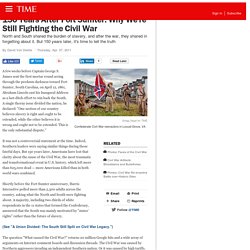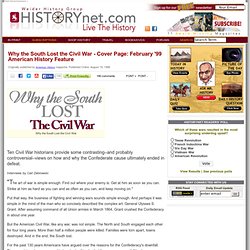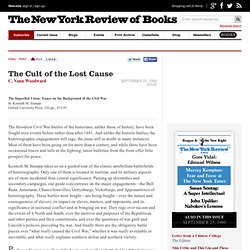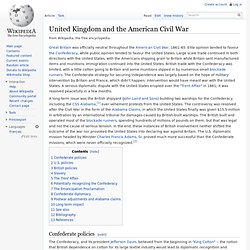

Why the U.S. Is Still Fighting the Civil War. A few weeks before Captain George S.

James sent the first mortar round arcing through the predawn darkness toward Fort Sumter, South Carolina, on April 12, 1861, Abraham Lincoln cast his Inaugural Address as a last-ditch effort to win back the South. A single thorny issue divided the nation, he declared: "One section of our country believes slavery is right and ought to be extended, while the other believes it is wrong and ought not to be extended. This is the only substantial dispute. " It was not a controversial statement at the time.
Indeed, Southern leaders were saying similar things during those fateful days. Shortly before the Fort Sumter anniversary, Harris Interactive polled more than 2,500 adults across the country, asking what the North and South were fighting about. Blight Vid 27 - Historiography & Legacy of ACW. James McPherson - Battle Cry of Freedom. BATTLE CRY OF FREEDOM: THE AMERICAN CIVIL WAR by JAMES McPHERSON [A page featuring selected quotes from this single-volume history of the Civil War era in America] Both sides in the American Civil War professed to be fighting for freedom.

Shelby Foote - Fort Sumter to Perryville. A page containing quotes from the late Shelby Foote, American writer and historian, focused on his epic "The Civil War: A Narrative.

" "The last romantic and first modern war. " - Shelby Foote's description of the American Civil War "History and literature are rarely so thoroughly combined as here. " - Peter S. Prescott, Newsweek on "The Civil War: A Narrative" "The lucidity of the battle narratives, the vigor of the prose, the strong feeling for the men from generals to privates who did the fighting, are all controlled by a constant sense of how it happened and what it was all about. Foote has the novelist's feeling for character and situation, without losing the historian's scrupulous regard for recorded fact. Shelby Foote - Fredericksburg to Meridian. A page containing quotes Volume Two of The Civil War: A Narrative from the late Shelby Foote, American writer and historian.

Volume Two covers events from Winter 1862 to Spring 1864. "Gettysburg is described with such meticulous attention to action, terrain, time and the characters of the various commanders that I understand, at last, what happened in the battle... Shelby Foote - Red River to Appomattox. A page containing quotes Volume Three of The Civil War: A Narrative from the late Shelby Foote, American writer and historian.

Volume Three covers events from Spring 1864 until the end of the war. "By way of possible extenuation, in response to complaints that it took me five times longer to write the war than the participants took to fight it, I would point out that there were a good many more of them than there was of me. However that may be, the conflict is behind me now, as it is for you and it was a hundred-odd years ago for them. " - Shelby Foote, closing out the third volume ~ Volume Three: Red River to Appomattox~ Chapter 1: Another Grand Design~ Chapter 2: The Forty Days — The Wilderness~ Chapter 3: Red Clay Minuet~ Chapter 4: War Is Cruelty...~ Chapter 5: ...You Cannot Refine It~ Chapter 6: A Tightening Noose~ Chapter 7: Victory, And Defeat~ Chapter 8: Lucifer In Starlight ~ Return to Volume One: Fort Sumter to Perryville~ Return to Volume Two: Fredericksburg to Meridian. Blight Vid 18 - Why the North won. VID: Why did the North win the ACW?
VID: The "Lost Cause" & why the South lost the ACW. 10 historians - Why the South Lost. Why the South Lost the Civil War Ten Civil War historians provide some contrasting–and probably controversial–views on how and why the Confederate cause ultimately ended in defeat.

Interviews by Carl Zebrowski "The art of war is simple enough. Find out where your enemy is. Get at him as soon as you can. Gallagher: The Confederate War. Farmer: Why was the Confederacy Defeated? Lost Cause of the Confederacy. Woodward on Stampp, onthe Lost Cause. The Imperiled Union: Essays on the Background of the Civil War by Kenneth M.

Stampp Oxford University Press, 320 pp., $15.95. (1) VID: Relative advantages of USA & CSA at outset of war. Last revised: March, 2014 Acceptance of Terms Please read this Terms of Service Agreement ("Terms of Service", "Terms of Use") carefully.

Blight 13 - Early relative advantages. Britain in the American Civil War. Great Britain was officially neutral throughout the American Civil War, 1861–65.

Elite opinion tended to favour the Confederacy, while public opinion tended to favour the United States. Large scale trade continued in both directions with the United States, with the Americans shipping grain to Britain while Britain sent manufactured items and munitions. Immigration continued into the United States. British trade with the Confederacy was limited, with a little cotton going to Britain and some munitions slipped in by numerous small blockade runners. The Confederate strategy for securing independence was largely based on the hope of military intervention by Britain and France, which didn't happen; intervention would have meant war with the United States. Foreign Affairs under Lincoln. Foreign Affairs A key part of Abraham Lincoln's military strategy rested upon an effective blockade of the South's 3,500 miles of shoreline, including a dozen major ports and nearly two hundred inlets, bays, and navigable rivers.

This was an almost impossible task for a nation with only a handful of naval ships. By the war's end, however, Lincoln had commissioned about five hundred ships, with an average of 150 on patrol at any one time. Socio-economic issues. VID: Impact on North & South. Last revised: March, 2014 Acceptance of Terms Please read this Terms of Service Agreement ("Terms of Service", "Terms of Use") carefully. These terms apply to Education Portal and its related websites owned and operated by Remilon, LLC ("Education Portal,", "Site", "Sites", "our", "us").
Education Portal provides the Services, which are defined below, to you subject to the following Terms of Service, which may be updated by us from time to time without notice to you. Blight Vid 17 - Homefronts. Contrasting economies. A War of Unequals Economically, the Civil War was not a contest between equals. The South had no factories to produce guns or ammunition, and its railroads were small and not interconnected, meaning that it was hard for the South to move food, weapons and men quickly and over long distances. Economy of the CSA. The Confederate States of America had an agrarian-based economy that relied heavily on slave-worked plantations for the production of cotton for export to Europe and the northern US states. If ranked as an independent nation, it would have been the fourth richest country of the world in 1860.[1] When the Union blockaded its ports in summer 1861, exports of cotton fell 95 percent and the South had to restructure itself to emphasize food production and munitions production.
After losing control of its main rivers and ports, it had to depend on a weak railroad system that, with few repairs being made, no new equipment, and federal raids, crumbled away. The financial infrastructure collapsed during the war as inflation destroyed banks and forced a move toward a barter economy for civilians. The government seized needed supplies and livestock (paying with certificates that were supposed to be paid off after the war, but never were).
By 1865 the economy was in ruins. CSA dollar. The Confederate States of America dollar was first issued just before the outbreak of the American Civil War by the newly formed Confederacy. It was not backed by hard assets, but simply by a promise to pay the bearer after the war, on the prospect of Southern victory and independence. As the war began to tilt against the Confederates, confidence in the currency diminished, and inflation followed. By the end of 1864, the currency was practically worthless. The Confederate Dollar (or "Greyback") is now a prized collector's item, in its many versions, including those issued by individual states and local banks. The various engravings of leading Confederates, gods and goddesses and scenes of slave-life, on these hastily printed banknotes, sometimes cut with scissors and signed by clerks, continue to stimulate debate among antique dealers, with even some of the counterfeit notes commanding high prices.
Background[edit] Economics and the Civil War. Union (American Civil War) Issues facing the North, 1860-61. VID: Politics in the North during the ACW. Confederate States of America. Newspapers in Virginia during ACW. Newspaper Culture. The Creation of Confederate Nationalism: Ideology and Identity in the Civil ... - Drew Gilpin Faust. Robert Toombes. Mark Scroggins. Robert Toombs: The Civil Wars of a United States Senator and Confederate General. Jefferson: McFarland, 2011. 242 pp. $40.00 (paper), ISBN 978-0-7864-6363-3. Reviewed by Jacob S. Clawson (Auburn University)Published on H-CivWar (March, 2012)Commissioned by Hugh F. Dubrulle A Georgia Firebrand in the Midst of the Sectional Crisis While not possessing the same profile as fellow southern politicians, such as Jefferson Davis or Alexander H.
Throughout his study of Toombs’s political evolution, Scroggins emphasizes the extent to which the Georgian could not balance his volatile personality with his otherwise keen political skill. Confederate Governors. CSA: overlooking slaves & white women. VID+ The ACW (1861-63) 8 Unusual Civil War Weapons — HISTORY Lists. Civil War Veterans Come Alive. Blight Vid 15 - Antietam and Emancipation. Blight Vid 16 - impact of Emancipation on ACW. Contribution of black troops. Timeline of black troops' actions in ACW. 6 Civil War Guerrilla Leaders — HISTORY Lists. During the Civil War, groups of so-called “partisan rangers” engaged in bloody campaigns of guerrilla attacks, raiding and psychological warfare against rival military units and civilians. The War List: Overrated Civil War Officers. ACW Union Generals, biographies. Did McClellan have a winning strategy? Grant, 1863-64. ACW Confederate generals' biographies.
VID: Lee v Grant (History Channel) VID: ACW Timeline 1861-1865. ACW battlefields & campaigns. Blight Vid 19 - Events of 1864-65. Blight Vid 14 - Events of 1862-63. VID: Key battles in 1863. 7 Things About Chancellorsville, 1863. VID: Gettysburg (introduction) How the Battle of Gettysburg Worked" Battle of Gettysburg Pictures" VID: Gettysburg (Day 1) VID: Gettysburg (Day 2) VID: Gettysburg (Day 3) VID: Key battles in 1862. Outline of military events. Battles and casualties.